Exercises (2269)
Push-up and moving an object to the side in the push-up position ► drag push up position
Power
Individual work




Push-up position, place an object (e.g. combat rucksack) on one side next to the hand (next to the little finger). Perform a push-up, grab the object and pull/push it to the other side, perform another push-up before returning the object to the starting position.
Attention:
Do not arch your back, tense your core.
Lighten:
Support in place; place your knees on the floor; only move the object between your arms.
Harden:
Additional weight (on your shoulders or for moving); unstable support for your legs.
1 combat backpack
1 weight vest/weight disc/sandbag/(additional) combat backpack ► making the exercise more difficult (additional weight)
1 sandbag ► making the exercise more difficult (load)
1 ball/1-2 balance cushions/1 balance board ► making the exercise more difficult (unstable base)
Push-up position
Power
Individual work


Progression I:
Adjust the sling trainer to mid-lower leg length (standing), support position with outstretched arms on the balance board with the feet vertically under the attachment point in the slings, hold position.
Progression II:
Integrate push-ups.
Caution:
Keep body tension, do not let hips sag, back straight, hands under shoulders (for both progressions).
1 sling trainer
1 balance board
Push-up position
Power
Individual work



Push-up position, legs (shins) placed on the exercise ball, alternately lift one leg slightly and return to the starting position.
Attention:
Head, shoulders, buttocks and feet form a line, no hollow back, actively tense the torso. To prevent the ball from rolling away, you can lean it against a wall.
Lighten the load:
Support yourself in place (without lifting and lowering your legs); exercise ball closer to your hips.
Lighten the load:
Additional weight (on your back); unstable support for your arms.
1 exercise ball
1 medicine ball/helmet/balance hemisphere
1 weight vest/weight disc/sandbag ►Make the exercise more difficult (additional weight)
Push-up position ► hand over push up position
Power
Partner work


Both participants stand at a distance of approx. 1 metre from each other in a frontal push-up position with their feet wide apart. The partners pass a ball back and forth (straight or crosswise) without it touching the floor. From time to time or after each pass, the participants change supporting hand.
Attention:
Keep the trunk stable and do not let it sag (constant tension).
Lighten:
Roll the ball on the floor to the partner; lighter ball.
Harden:
Heavier ball; additional weight (on the back).
1 weight ball
1 ball (e.g. volleyball/football/basketball) ► Make the exercise easier
1 weight ball/medicine ball ► Make the exercise more difficult (additional weight)
1 weight vest/weight disc/sandbag ► Make the exercise more difficult (additional weight)
Push-up position on knees low ► knee push up hold / kneeling push up hold (normal grip)
Power
Individual work
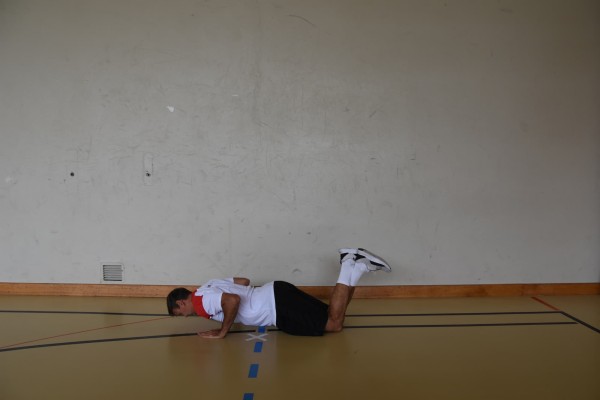
In the knee push-up position (knees on the floor, feet held high with toes raised, body forming a straight line from head to knees, hands slightly more than shoulder-width apart under the shoulders), bend the arms and hold the position. In the deep push-up position, the elbows are at the side of the body (no outward movement of the elbows).
Attention:
No hollow back and elbows bent at an angle of approx. 45° from the upper body ("A" shape with the arms). Keep your shoulders fixed and pull them down towards your hips.
Lighten:
Lower your upper body less (hardly bend your arms); support your arms on a raised surface.
Harden:
Additional weight (on the back); unstable support for the arms and/or legs; perform normal push-ups without knee support.
Variant:
Vary the position of the hands/arms (e.g. wide, narrow, together).
1 weight vest/weight disc/sandbag/fighting backpack ► Make the exercise more difficult (additional weight)
1 ball/1-2 balance cushion/balance board ► Make the exercise more difficult (unstable base)
1 raised base ► Make the exercise easier or more difficult (position)
Push-up position high
Power
Individual work

High push-up position (support), hold position.
Attention:
No hollow back, elbows bent approx. 45° from upper body ("A" shape with arms), shoulders are fixed and pulled down towards hips.
Lighten:
Place knees on floor (feet in high position); support arms on raised surface.
Harden:
Additional weight (on your back); place your legs on a raised surface; unstable surface for your arms and/or legs; hold a low push-up position.
Variant I:
Vary the position of the hands/arms (e.g.: wide, narrow, together).
Variant II:
Alternate touching the opposite shoulder with your hand.
1 weight vest/weight disc/sandbag ► Make the exercise more difficult (additional weight)
1 ball/1-2 balance cushion/balance board ► Make the exercise more difficult (unstable base)
1 raised base ► Make the exercise easier or more difficult (position)
Alternating push-up position and upright standing position ► jump back
Power
Individual work






From a standing position, bend your legs, place your hands in front of your feet and jump backwards with both legs at the same time to get into a push-up position. Then jump back forwards with both legs to the starting position of the legs, from this squatting position straighten back up to standing. Cross your arms behind your head and push your pelvis forwards (hollow back) before returning to the starting position in an upright position to start the exercise again.
Attention:
No hollow back in the push-up position (body tension).
Lighten:
Lower intensity between the individual exercises.
Harden:
Additional weight (on the legs).
2 weight cuffs/1 weight waistcoat ► Make the exercise more difficult (additional weight)
Push-up position and jump to the side alternating ► burpee & box jump over / side jump
Power
Individual work















Stand upright and stand next to a raised object (plyo box or vaulting box element incl. top). From a standing position, bend your legs and place your hands next to your feet to get into a squat position. Support yourself with your hands, jump backwards with both legs to get into the push-up position. Bend your arms to fully lower your upper body (prone position). From the prone position, push back into the push-up position with both arms and jump back into the squat position. From the squat position, powerfully push your legs off the floor to perform a sideways jump onto the raised object (use the momentum of your arms). Without straightening the upper body and stretching the legs (again in the squat position), immediately jump again to the other side of the raised object. After landing (no need to stand upright), restart the exercise sequence from the squat position and then jump back to the starting position.
Attention:
Land as softly as possible on the box and then immediately jump again.
Lighten:
Lower intensity between each execution; lower height to jump over.
Harden:
Additional weight; higher object to jump over.
Variation:
Frontal jumps up and down from the object.
1 flat bench/plyo box/swivel box
2-4 weight cuffs/1 weight waistcoat ► Make the exercise more difficult (additional weight)
Push-up position and stretch jump alternating ► half burpee
Power
Individual work




From a standing position, bend your legs, place your hands in front of your feet and jump backwards with both legs at the same time to get into a push-up position. Then jump back forwards with both legs to the starting position of the legs, perform a stretch jump from this crouching position (optionally cross your arms briefly behind your head during the flight phase) and land back in the starting position to begin the exercise again.
Attention:
No hollow back in the push-up position (body tension).
Lighten:
Lower intensity between the individual exercises; lower height during the stretch jump (or only straighten the upper body).
Harden:
Additional weight.
2-4 weight cuffs/1 weight waistcoat ► Make the exercise more difficult (additional weight)
Alternating push-up position and stretch jump ► scaled burpee
Power
Individual work











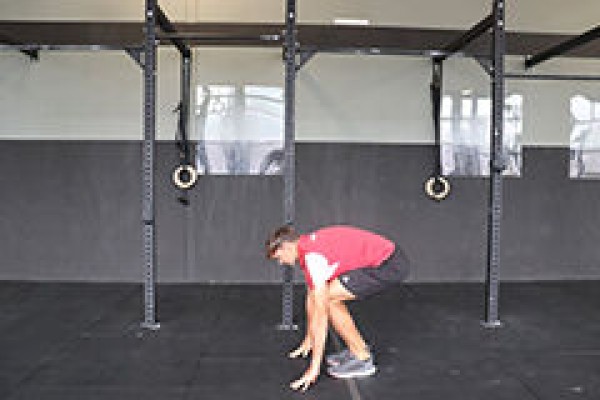

From a standing position, bend your legs and place your hands next to (in front of) your feet to assume the squat position. Support yourself with your hands and alternately move one leg backwards to reach the push-up position. Bend your arms to fully lower your upper body (prone position). From the prone position, use both arms to push yourself back into the push-up position, then alternately move one leg back into the squat position. From this squatting position, perform a stretch jump (optionally cross your arms briefly behind your head during the flight phase) and land back in the starting position to begin the exercise again (change which leg is moved backwards or forwards first for each exercise).
Attention:
No hollow back in the push-up position (body tension).
Lighten:
Lower intensity between the individual exercises; lower height during the stretch jump (or only straighten the upper body).
Harden:
Additional weight.
2-4 weight cuffs/1 weight waistcoat ► Make the exercise more difficult (additional weight)
Deep push-up position ► push up plank hold
Power
Individual work

Deep push-up position, hold position.
Attention:
No hollow back, elbows bent approx. 45° from upper body ("A" shape with arms), shoulders are fixed and pulled down towards hips.
Lighten:
Place knees on floor (feet in high position); lower upper body less (arms barely bent); support arms on raised surface.
Harden:
Additional weight (on the back); place legs on a raised surface; unstable surface for the arms and/or legs.
Variant:
Vary the position of the hands/arms (e.g.: wide, narrow, together).
1 weight vest/weight disc/sandbag ► Make the exercise more difficult (additional weight)
1 ball/1-2 balance cushion/balance board ► Make the exercise more difficult (unstable surface)
1 raised surface Make the exercise easier or ► Make the exercise more difficult (position)
Push-up position and forearm support alternating ► push up position & elbow plank / push up position & front plank / push up position to elbow plank / push up position to front plank
Power
Individual work



Switch from the push-up position to the forearm support and back (bend and stretch one arm at a time).
Attention:
Head, torso, hips and knees practically form a line (do not stretch your buttocks upwards or let them sag, tense your stomach).
Lighten:
Knees on the floor.
Harden:
Additional weight (on the back); unstable base for the legs.
1 weight vest/weight disc/sandbag ► to make the exercise more difficult (additional weight)
1 ball/balance cushion/balance board ► to make the exercise more difficult (unstable surface)
Liegestützposition und Unterarmstütz alternierend ► push up position & elbow plank / push up position & front plank / push up position to elbow plank / push up position to front plank
Power
Individual work

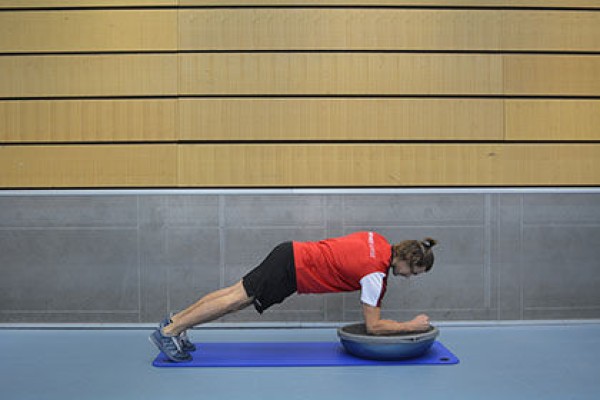
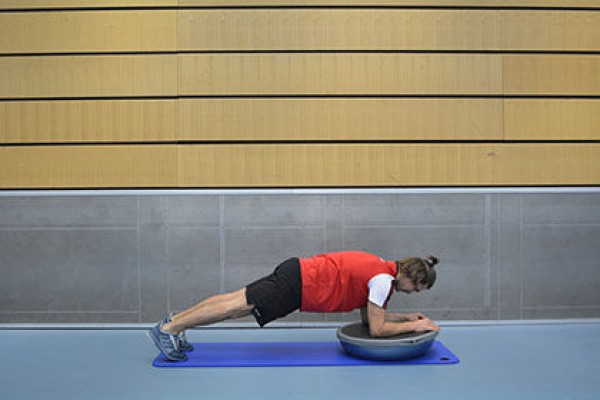

Switch from the push-up position to the forearm support and back (bend and stretch one arm at a time), placing the hands or forearms on a balance ball.
Attention:
Head, torso, hips and knees practically form a line (do not stretch your buttocks upwards or let them sag, tense your stomach).
Lighten:
Perform the exercise without the balancing hemisphere; knees on the floor.
Harden:
Additional weight (on the back); unstable base for the legs.
1 balance hemisphere
1 weight vest/weight disc/sandbag ► to make the exercise more difficult (additional weight)
1 ball/balance cushion/balance board ► to make the exercise more difficult (unstable base)
Liegestützposition und Unterarmstütz alternierend ► push up position & elbow plank / push up position & front plank / push up position to elbow plank / push up position to front plank
Power
Individual work


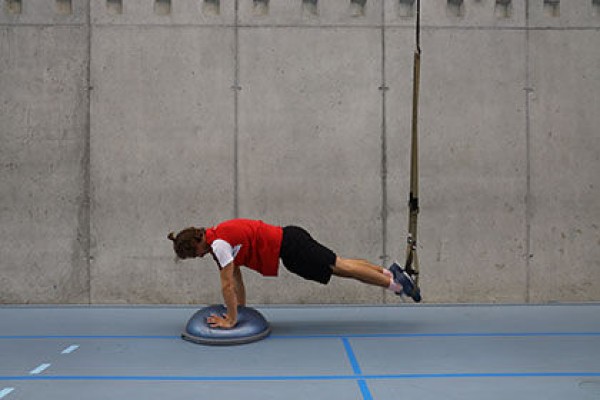
Switch from the push-up position to the forearm support and back (bend and stretch one arm at a time), with the hands or forearms placed on a balance hemisphere and the feet in the sling trainer (adjust the sling trainer to the length of the centre of the lower leg - while standing; feet vertically under the attachment point).
Attention:
Head, torso, hips and knees practically form a line (do not stretch your buttocks upwards or allow them to sag, tense your stomach).
Lighten:
Perform the exercise without the sling trainer and/or balance half-ball.
1 balance hemisphere
1 sling trainer
Push-up competition
Fighting and roughhousing games
Partner work

Two participants assume the push-up position (facing each other). The participants try to unbalance each other by pulling their arms away (or dodging). Whoever leaves the push-up position first (e.g. knees touch the floor) loses.
No material required
Push-up competition
Fighting and roughhousing games
Group work
The participants assume the push-up position and try to make another participant fall (knees on the floor) (pull hands away, push, dodge, unbalance, etc.). Whoever leaves the push-up position is eliminated and performs an additional exercise (e.g. wall sit, push-ups, forearm support). Which participant remains in the push-up position until the end?
No material required
Line run
Orienteering
Single run or groups of 2/3
Send participants/groups onto the course in staggered formation (note the distance to the first starter/starting group on the run card)
In the terrain, the sports director distributes controls in advance, which the participants then run to individually or in small groups during the line run. For this purpose, the participants receive a control overview and a running map. The controls are run in numerical order. The line run can be carried out both as an exercise and as a competition. It is worth staggering both variants so that each participant/group has to work independently and cannot simply follow a forerunner/group (note the time intervals/difference to the first start time on the run card for evaluation purposes). The control overview with the running map can either be handed out together with the start signal or distributed to the runners/groups a certain time before the start. For the line run, each participant/group has a defined amount of time to find as many or as many controls as possible.
Variant I:
Prepare the control transfer point: The participants do not receive a map on which the controls are already marked, but must mark the controls themselves at a control transfer point (e.g. using coordinates, azimuth or measuring point method). The control sheets remain at the start even after the transfer. Before the participants set off on the course, the sports director checks the marked controls.
Variant II:
The control that must be approached first is marked on the map. In this variant, the participants can also be sent on the course without staggering, as they do not start in the same direction. However, this varies the running distances (rather unsuitable as a form of competition).
Orienteering controls (to be unplugged)
1 stopwatch
Participant/group:
1 orienteering map with control overview incl. designation (prepared in advance by the sports director)
1 running map form 30.063
1 bussole
Variation of the exercise:
Participant/group:
1 control transfer sheet
1 map scale
1 pencil and eraser
Line drawing
Fighting and roughhousing games
Partner work

Two participants stand opposite each other on a line and grab each other by one hand or forearm. The participants try to pull their opponent over the line. Whoever crosses the line first loses.
Variant:
Whoever has to lift one leg off the ground first loses.
2 marking cones/caps (optional) ►Pitch marking
Post setup:
Caps mark the centre line.
Mat disposal
Fighting and roughhousing games
Group work
2-4 groups with 6-14 participants each
The group lines up behind a starting marker. There is a large soft mat in front of the group. On the start command, a binomial (possibly holding hands) or a single participant jumps onto the mat. After the jump, the next pair/participant is handed over, who in turn jumps onto the mat. The aim of mat jumping is to jump onto the soft mat in such a way that the mat is propelled as far forwards as possible. The winner is the group that gets their soft mat over a line or against a wall first. To ensure that the mat is not pushed further forwards when climbing down, the mat must always be left in the direction of the goal.
Per group:
1 soft mat (large)
1 marking cone/cap/painting stick
Mat fight
Fighting and roughhousing games
Group work
Groups of 2 (groups of 4-8 for the variation of the exercise)
Multiple groups of 2 try to push down the mats of the opposing teams with their mats held above their heads. Which team can hold their mat up the longest?
Variant:
Replace larger groups and the small ones with large mats.
Per group:
1 soft mat (small)
4 soft mats (large) ►Variation of the exercise
Mat pushing
Fighting and roughhousing games
Group work
2 groups with 3-5 participants each
Two teams try to push a mat over an agreed opponent's boundary. The point of attack is only the mat and not the opponent.
1 soft mat (large)
Wall displacement
Fighting and roughhousing games
Group work
2 groups with 6-10 participants each
Two groups line up back to back along a line. The participants in both groups hook each other with their arms. The teams try to push each other over a previously agreed line.
No material required
4 marking cones/caps (optional)
Avoidance artist
Light-Contact
Partner work
Regular change of roles and partners
.

Participant A stands in a stepping position with their arms crossed behind their back and their front foot in a tyre. Participant B stands in box position and is allowed to move freely. Participant B now tries to hit A on the forehead with single straights (no series, combinations or feints). A tries to prevent these hits by avoiding them. Each hit scores one point. If B hits too hard, all points are lost. Roles change after a set time or after reaching a certain number of points.
Variations:
- Feint allowed;
- Do not perform as a competition form. B deliberately hits slower so that A can practise avoidance;
- Avoidance to the back not allowed, only to the side and downwards;
- Cover/block allowed.
Participant:
1 pair of boxing gloves
Participant:
1 tyre
Mini-Tennis
Games / Tournament
Game idea:
Two parties face each other on the court and try to score points by playing the ball into the opponent's court so that the opponent can no longer return the ball according to the rules. The game is analogous to tennis.
Scoring points:
A point is scored when the cue ball touches the ground twice in succession in the opponent's half of the court, with the first touch occurring within the marked area or when the opponent is unable to return the ball in accordance with the rules.
Court:
A net (can also be improvised) is stretched to a height of approx. 1.1m (top edge). The court is defined with lines or cones (e.g. badminton court; half a tennis court).
Number of participants:
1 against 1 (singles) or 2 against 2 (doubles)
Rules of the game:
The serve is made from below behind the baseline. At the time of the serve, the opponent is also on the baseline. The serve may not be taken directly from the air. The serve must be hit over the net into the opponent's court. There are no rules regarding cross serves. The serve is awarded to the player who has scored the point.
The game is played to a defined number of points (e.g. 15 points) or to a specific time. Each error (ball not returned in accordance with the rules, i.e. the ball is played out of bounds or into the net or does not reach the net at all) results in a point for the opponent. The ball is considered "out" if it has landed completely outside the line. Rolling the ball over the net is permitted, but touching the net by the player is prohibited. The racket may not protrude over the net into the opponent's court.
Mini tennis: Collect hits
Forms of play / exercises
Partner work
Two players stand opposite each other on either side of the net and try to fulfil various tasks in which hitting a newspaper plays a central role (note: if the game is played in the field and the weather is windy, this type of exercise is less suitable):
- Exercise to improve technique: try to hit a newspaper placed in the middle of the court (forehand/backhand). Both players are predominantly on the baseline.
- Exercise form to improve technique: newspaper placed in the centre of the court, try to hit it by playing at the net (volley). One player at the net (volley), the other plays the balls to (forehand/backhand).
- Technique training combined with competition form: newspaper placed in the centre of the court, try to hit (forehand/backhand). With each hit, the newspaper is cut in half. Which participant has the most folded newspaper after a certain time?
- Technical training combined with competition form: try to hit a newspaper placed on a certain line (forehand/backhand). With each hit, the newspaper is moved back one line. Which participant on each side of the court has moved their newspaper furthest away from the net after a certain time?
Pro Tn:
1 Smolball bat
1 newspaper